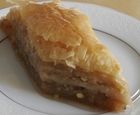|
Greek Dessert Honey Nut Pastry Personally? I would go out and buy this. But for adventurous souls, with good arches and sturdy legs, this is a great recipe.
40 sheets filo pastry, 2 boxes (thaw according to Syrup & Filling: first, prepare syrup by combining sugar, water and lemon juice in a saucepan. Stir to dissolve sugar, bring to a boil, and add rosewater. Do not stir once syrup reaches a boil (it may cloud); simply remove from heat and cool. In a separate bowl, combine nuts and spices with sugar and set aside. Pastry*: preheat oven to 350. Grease a 9 x 13 baking pan. Stack filo sheets on a flat surface and trim to fit baking pan. Layer 12 sheets in greased pan, brushing the top of each sheet with melted butter before adding the next. Top those sheets with remaining of nut mixture and add the final 12 sheets, buttering each individually. Brush the top sheet with the remaining butter. (You will have four separate filo layers: 12-8-8-12.) Baking: Before baking, cut pastry into 2” diamond shaped pieces, being sure to cut all the way through. Bake 30 minutes at 350—then reduce heat to 200 and bake another 30 minutes. Remove from oven and pour syrup over warm pastry. It should rest for several hours before serving. *While working with one sheet of filo, cover others with a slightly damp towel, or plastic, to prevent them from drying out. |
Tips & Glossary You may not have a number of ingredients used in Greek cooking in your spice shelf, but you can find them at Mid-Eastern food stores. So to avoid frustration, make a list of the items you need before trying out the recipes. Filo: aka phyllo, paper-thin sheets of raw, unleavened flour dough. Purchase frozen in most grocery stores and follow directions on package for thawing. When working with a sheet, keep others covered with a damp towel to prevent drying out. Grape Leaves: Grape leaves are sold canned in salted oil. Rinse off the salt before using. If you want, prepare your own: find fresh, tender young leaves and plunge them for 1 minute into boiling water (with 1 or 2 T lemon juice). Then proceed with recipe. After blanching, you can freeze them for later use. Here’s how: blanch as above, dunk in iced water, pat dry with towels, and seal in an air-tight plastic bag. They're safe for 6 months, but use quickly when thawed. Nutmeg: Use small whole nuts and store them, tightly covered, in a dry dark area. Grate what you need using the smallest grating edge or grind in a food processor. What a difference from store bought nutmeg! Pine Nuts: edible seeds of pine trees used in many Greek dishes. Before cooking, release flavor by lightly browning in a heated skillet Skewers: Use metal or wooden skewers for kebobs. If wooden, soak 30 minutes before using to prevent them from catching on fire. Rosewater: distilled from rose petals and used to flavor Mid-Eastern and Asian cooking. You can make your own. But, seriously, why would you? Purchase it at Asian or Mid-Eastern stores. Semolina: aka farina or Cream of Wheat; a coarsely ground wheat grain. You also know it as couscous. If made from durum wheat, it is used to make pasta. Tarama: poor-man's caviar. From carp roe, it is pinkish-orange and is what (along with food dye) gives taramasalata its lovely color. Buy it jarred in Mid-Eastern food stores.
|
Site by BOOM
![]()
LitLovers © 2024

